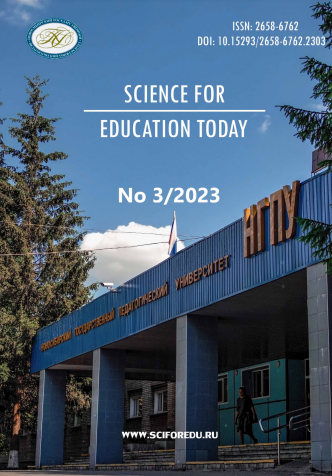Динамика изменений профессиональной мотивации обучающихся: влияние институциональной интеграции
Dynamics of students’ professional motivation: The impact of the institutional integration
Author(s): Tatiana Alekseevna Bezusova, Tatyana Vasilyevna RichterSubject(s): Vocational Education, Higher Education , Educational Psychology, Social psychology and group interaction, Behaviorism, Methodology and research technology, Evaluation research, Sociology of Education
Published by: Новосибирский государственный педагогический университет
Keywords: Integration model; Secondary vocational education; Higher education; Supplementary education; Professional motivation; Level of motivation; Mid-level specialists;
Summary/Abstract: Introduction. The article presents an overview of research investigations on the problem of improving the efficiency of university educational process through the integration of secondary vocational and higher educational institutions. The purpose of the article is to identify the specifics of the impact of using the model of integration of secondary vocational and higher educational institutions on increasing the level of students’ professional motivation. Materials and Methods. The study has been conducted on the basis of a theoretical analysis and generalization of scholarly literature on the impact of using the model of integration of secondary vocational and higher educational institutions on increasing the level of students’ professional motivation. The empirical data were collected via experimental methods of educational research including test for evaluating the motivation for teaching called ‘Motivation for labor activities’ by K. Zamfir modified by A. Rean. Methods of mathematical statistics were used in order to process the empirical data (U-Mann-Whitney criterion). Results. The authors described an educational model for the integration of secondary vocational and higher educational institutions. The core of integration is a secondary vocational educational program in Supplementary education implemented in the conditions of a higher educational institution. The study identified the advantages and disadvantages of such collaboration, described the possibilities of modeling the curriculum for training mid-level specialists, taking into account the involvement of higher education disciplines. The results of a pilot experiment on implementing the program in Supplementary education in the conditions of higher educational institution were presented. The authors substantiated the positive impact of using the integration model of secondary vocational and higher educational institutions on increasing students’ professional motivation. Conclusions. The authors conclude that the model of integration of secondary vocational and higher educational institutions provides a positive trend in increasing the level of students’ professional motivation. The results presented in the work can be used to improve the efficiency of educational process at the university
Journal: Science for Education Today
- Issue Year: 13/2023
- Issue No: 3
- Page Range: 125-141
- Page Count: 17
- Language: Russian

